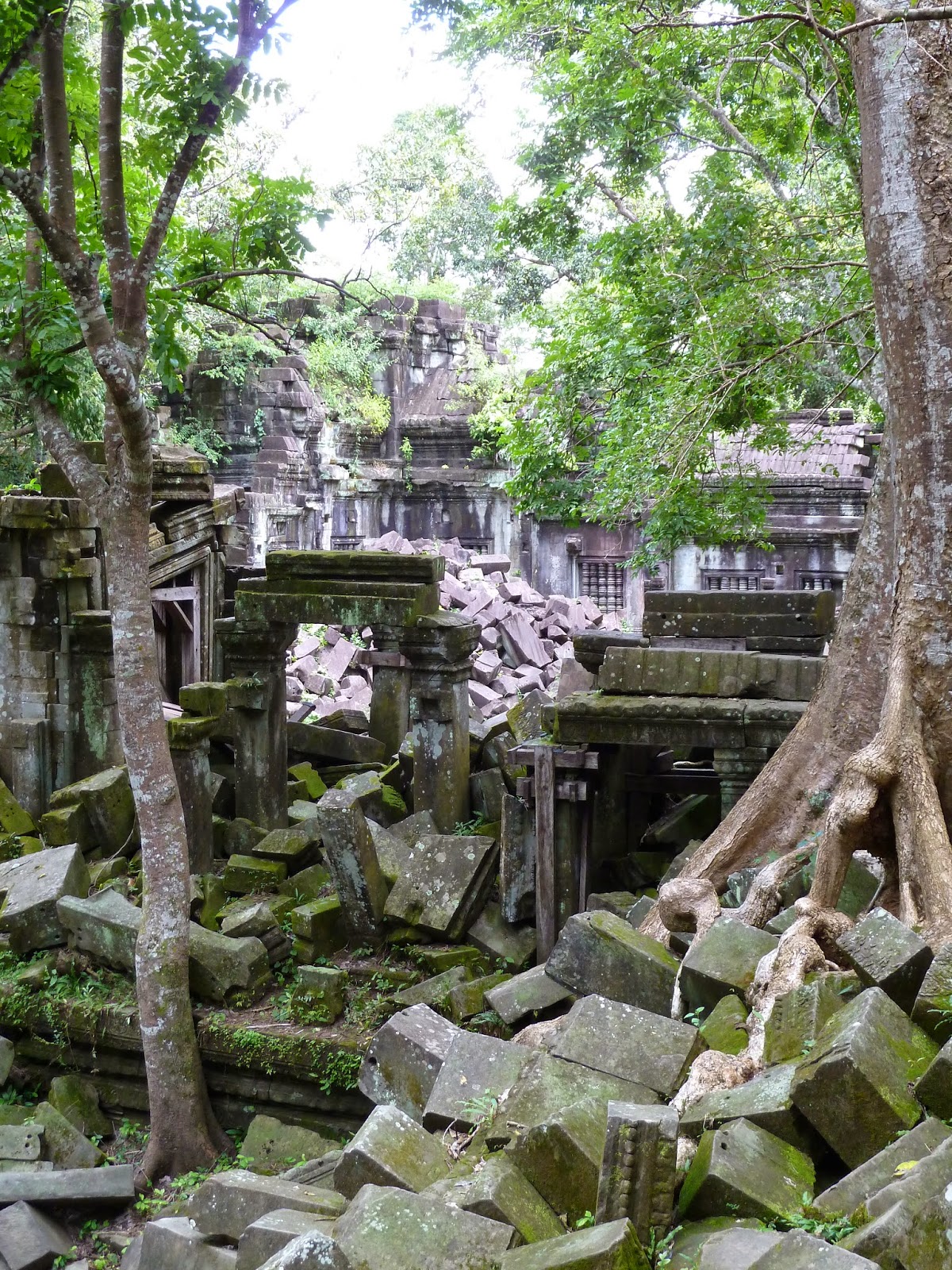The purpose of most visits to Siem Reap is to explore the architectural remains of the Khmer Empire, which had it's beginnings around 800 AD. The name of the city, "Siem Reap", translates to mean "Defeat of Siam", with Siam being known today as Thailand. Cambodia has a history full of conflict with Thailand and Vietnam, and suffers tremendously under the of the affects of war. It is hard to believe the war with Vietnam ended so recently, in 1998.
I was surprised that most of the land is quite wet, which makes for very lush green countrysides and excellent rice production. We saw a lot of rice and tapioca fields and production along the roadsides that we traversed out of town. Siem Reap has a healthy tourist economy, and is highly rated among the top tourist destinations. We found it to be one of the most pleasant cities we have visited, because of the ease of travel, and the genuine kindness of the people and their desire to make you feel comfortable and appreciated. Competition for tourist dollars keeps prices low and service excellent. In the heart of the small city is a popular "Pub Street" and night market, where we enjoyed some wonderful Cambodian (and other ethnic) restaurants, and bought a few spices and souvenirs. Yes, they were selling snakes and spiders on skewers for the daring (not us) to sample!
We first visited a small Landmine Museum (click here), to better understand the challenges the citizens of Cambodia face as a result of war. The Cambodian who runs this museum was a child soldier in the Khmer Rouge Army for which he fought for 35 years, and his responsibility was to place landmines in enemy territory. He has since made it his life mission to help find and diffuse the estimated 5,000,000 mines which have killed or maimed 1 in 290 Cambodians. He also takes in injured or orphaned children and provides them a home and education. Because Bob has a brother who died as a result of a landmine found in the Civil War territories of Virginia in which his family grew up, this is a cause that tugs at my heart. Each child tells his tragic story through artwork found in the museum.
Our first Khmer temple to visit was Bantaey Srei, a small but highly revered temple built in 967 AD. It was discovered in 1914 and restored in 1930. Made of red sandstone, it is carved with exquisite skill and is known as the jewel of Khmer art because of it's elaborate decorative carvings. The variegated colors of the sandstone add to it's beauty.
As we were leaving Bantaey Srei, we were entertained by the music of traditional Cambodian instruments. From there, we drove to the quarry to see where the stones for the Khmer temples were obtained. After cutting the stones, they were placed on barges which carried them down the river and man-made canals toward Siem Reap. The river quarry is now a popular swimming hole for children from the local village. Our guide showed us an interesting plant growing in the area, that when touched, reacts by immediately shrinking in size. (Compare left and right sides of the plant in the photo below.)
We continued on our journey to Beng Mealea, to explore the ruins of a temple thought to have been built during the 12th century. This was an "Indiana Jones" experience of sorts, because the temple ruins lie deep in the jungles of Cambodia and have not been restored. This was probably my favorite temple site because of the natural condition of the ruins and surroundings, and the fewer number of tourists.
The last stop on our tour was the Rolous Group of temples which were built in the late 9th century in an area that was once the first major capital of the Khmer Empire. We first visited the Lolei Temple site which was being restored. At this site are four brick towers created in honor of the king's ancestors and a Monastery.
Nearby was the Preah Ko Temple, which we explored in a light rain. It is made up of six towers, of which the three front structures were built to honor the founder of the Khmer Empire, his father, and grandfather. The three towers in back were dedicated to their respective wives.
The last temple in the Rolous Group we visited was Bakong. This temple was much larger than the others, and was a five-level stepped pyramid. Like many of the temples, the pathway leading across the bridge over the moat is guarded by a "Naga", or seven-headed cobra. Large stone statues of elephants and lions adorned the temple.
We enjoyed a nearly perfect first day in Cambodia. October is the end of the rainy season and the temperature - though hot - was not unbearable. It was exciting to witness a torrential rainfall which flooded the area for about an hour during our lunch break. But the timing was perfect and the few drizzles we experienced later that afternoon just kept us cool. Worn out, we returned to our comfortable hotel to enjoy dinner and retire in preparation for a very early start the next morning.



























































































No comments:
Post a Comment